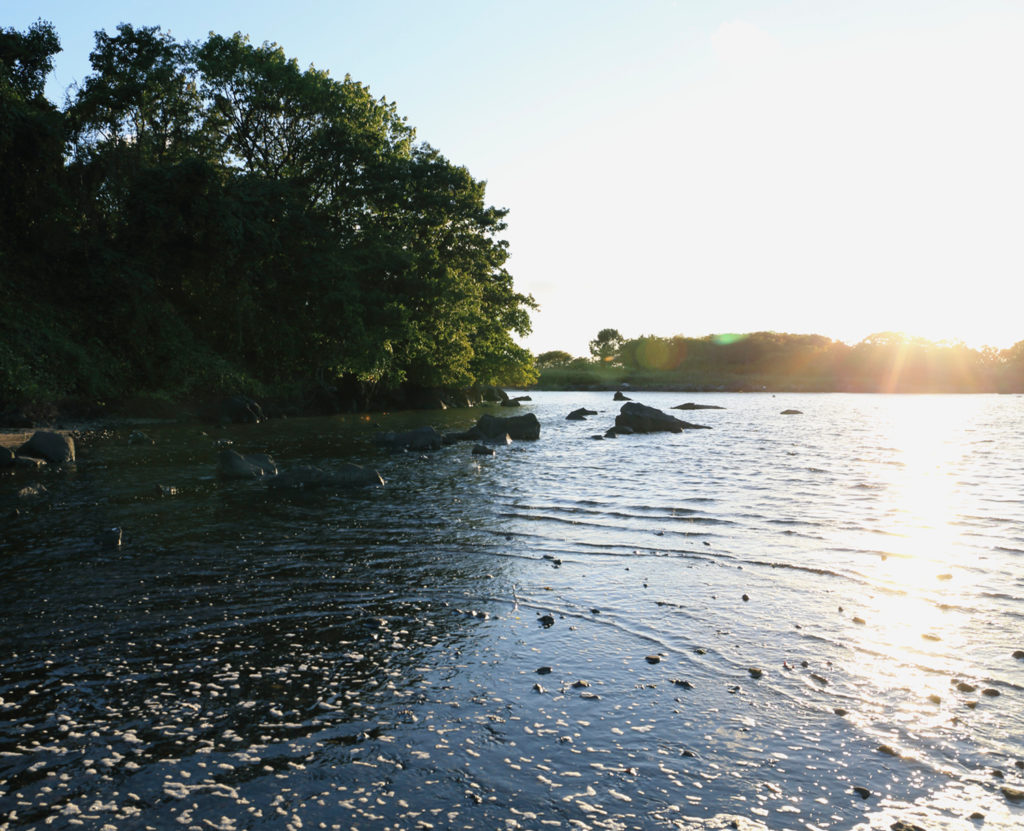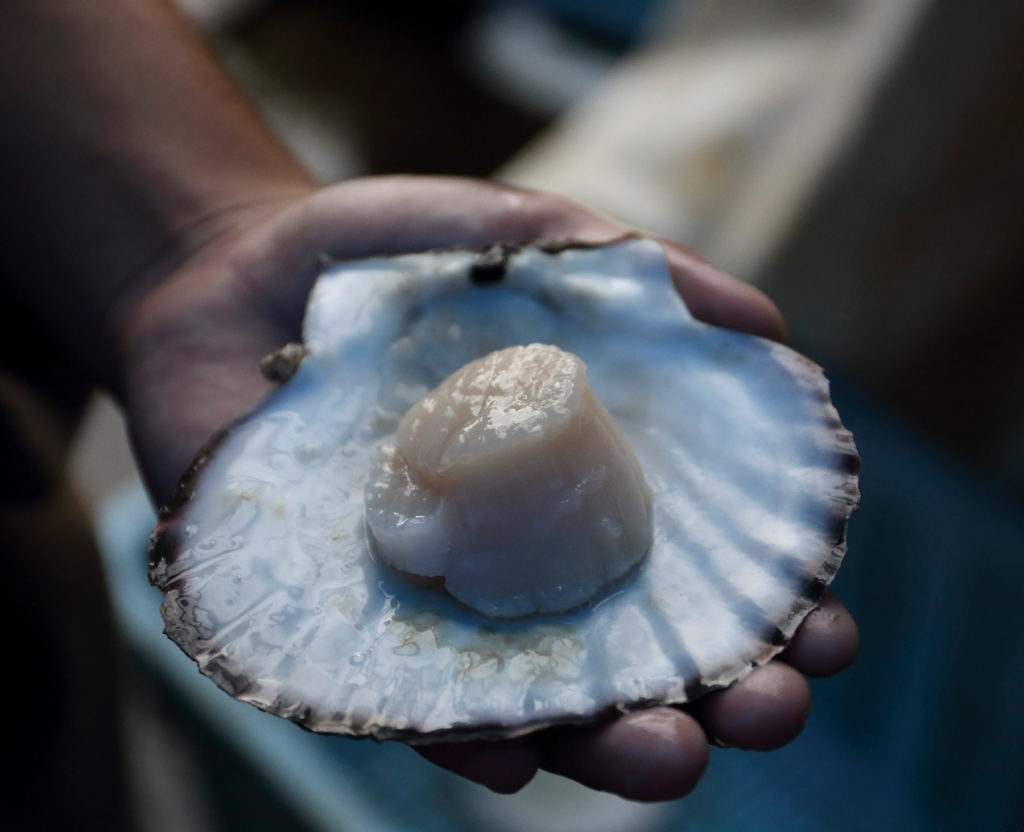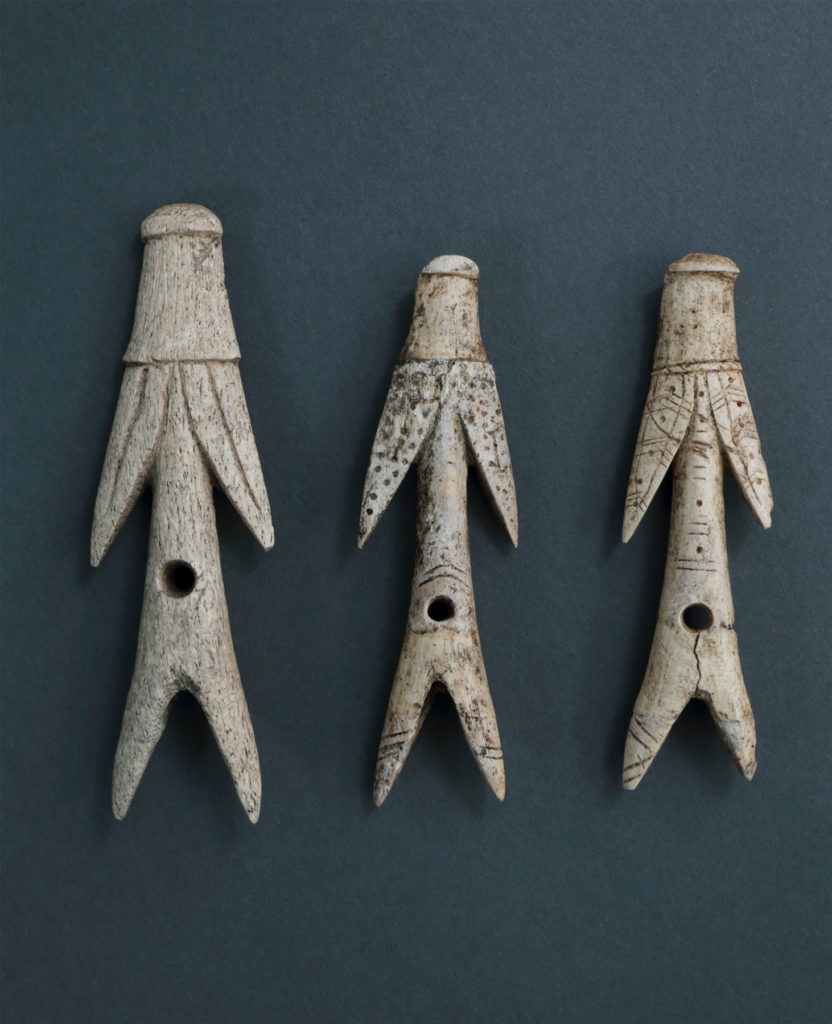The Quiet on Moshiri Island
This anthropomorphic figurine has a round head atop a pair of pointed, dangling arms and a slender physique with a gaping hole of a navel… Pardon my imagination. The three bone objects laid out before me (collection of Date City, Hokkaido) were hunting tools for catching seals and dolphins out at sea. They are believed to have been attached firmly to the end of a harpoon. Enchanted by the ornamental design of artifacts like this, I visited the town of Usu in Date City.
In Japan’s northernmost island of Hokkaido, one often runs into place names that derive from the indigenous Ainu language. The small island off the coast of Usu Bay, for instance, is called Moshiri, meaning “land” in Ainu. This uninhabited island some 10,000 square meters in size was only a stone’s throw from Usu Fishing Port. It was so close that I might have been able to walk there at low tide. But that wasn’t an option for me on this early morning at high tide. I strolled around the vicinity instead, hoping to find a small boat, and met a group of fishermen. Apparently, they had just returned from the morning catch. As we went on talking, they offered me a ride to the island, and I got on board with a young fisherman. He took me once around the island—Moshiri is flat and triangular—and then docked the boat. I made my way through the vegetation, stepped onto the island, and looked back at the port. The shore of Hokkaido was a mere 150 meters away. Moshiri was surrounded by water and dotted with large rocks, and yet the dense coverage of thickets and shrubs suggested that the island was not a habitat for birds. It was still and quiet. Excavations of the archaeological site on Moshiri have turned up shell mounds and numerous graves dating back to between the Final Jomon (ca. 3,200–2,500 years BP) and Epi-Jomon (ca. 2,500–1,400 years BP) periods. But there were no dwelling sites to speak of. Perhaps this quiet island has long been reserved as a special place for wildlife and the deceased.

Back at the port, the fishermen invited me to join them for breakfast. In the boathouse was a water tank where the freshly caught fish were swimming in a jumble. On closer look, fish like crest head flounder, white croaker, and bastard halibut were mixed with random sea cucumbers and even a small shark that accidentally got tangled up in the net. The strainers next to the tank contained shellfish—scallop, oyster, and whelk. When the suntanned fishermen started discussing their feats out at sea, somehow the lives of the Jomon people didn’t feel so distant from ours.


As I tended to the whelks that were rinsed in seawater and sizzling in their shells on an upside down 5 gallon can, I was served two helpings of scallop. One was wild and the other was farmed. The fishermen’s smiles urged me to try them. Both were deliciously salty from the seawater and tasted soft and sweet, as fresh seafood should. So which one was wild? I followed my instinct, and luckily, gave the right answer. One had a clean, well-balanced taste, and I guessed this one was farmed. The other had a more complex taste, like a blend of multiple flavors that was difficult to put a finger on. Thanks to these fishermen I met by chance and ended up joining for breakfast, I was feeling much closer than before to the Jomon hunters.
The fascinating thing about the Jomon culture on Hokkaido is that even after mainland Honshu transitioned into an agricultural society in the Yayoi period (ca. 500 BC–AD 300), the lifestyle based on fishing, hunting, and gathering wild plants and animals continued, and this was carried over to the Epi-Jomon period and into the Okhotsk culture, Satsumon culture, Ainu culture, and perhaps more loosely, to the present. I expect to be doing a good deal more fieldwork in Hokkaido this summer.
<PAPERSKY no.48(2015)>

Jomon Fieldwork | Nao Tsuda × Lucas B.B. Interview
A conversation between ‘Jomon Fieldwork’ Photographer and writer Nao Tsuda and Papersky’s Editor-in-chief Lucas B.B. The two discuss the ways Jomon culture continues to play an important role in modern day Japan. The video was filmed at Papersky’s office in Shibuya in conjunction with Tsuda’s exhibition “Eyes of the Lake and Mother Mountain Plate” held at the Yatsugatake Museum in Nagano.
Nao Tsuda | Photographer
Through his world travels he has been pointing his lens both into the ancient past and towards the future to translate the story of people and their natural world.
tsudanao.com











